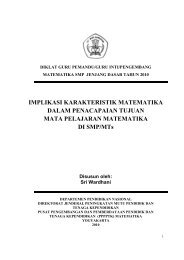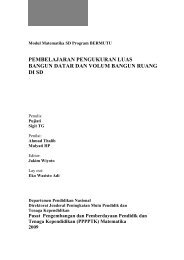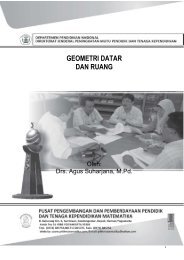25 Biggest Mistakes Teachers Make and How to Avoid Them
25 Biggest Mistakes Teachers Make and How to Avoid Them
25 Biggest Mistakes Teachers Make and How to Avoid Them
You also want an ePaper? Increase the reach of your titles
YUMPU automatically turns print PDFs into web optimized ePapers that Google loves.
116 Classroom Management <strong>and</strong> Instruction<br />
either a result of his busy schedule<br />
<strong>and</strong> unwillingness <strong>to</strong> commit <strong>to</strong> a<br />
time, or his response was deliberately<br />
unaccommodating <strong>to</strong> cause the<br />
student some discomfort about missing<br />
the test. Whatever his intent, he<br />
misjudged the importance of the<br />
make-up <strong>to</strong> the student.<br />
<strong>Teachers</strong> should establish a test<br />
<strong>and</strong> assignment make-up policy at<br />
the beginning of the school year<br />
clearly delineating if <strong>and</strong> when a<br />
make-up test is allowed. These<br />
make-up test guidelines should<br />
acknowledge extenuating circumstances<br />
such as illness, death in the<br />
SCENARIO 14.17<br />
Can’t You See That I Can’t See?<br />
family, <strong>and</strong> so on. The goal of the<br />
make-up policy should be <strong>to</strong> maximize<br />
student participation in class<br />
assignments. If a student has a tiny<br />
flicker of responsibility about a<br />
missed assignment, teachers have an<br />
obligation <strong>to</strong> fan that flicker in<strong>to</strong><br />
flames by helping the student make<br />
up the assignment. This teacher<br />
could have fanned this student’s<br />
flicker by simply designating a better<br />
time <strong>to</strong> discuss the test <strong>and</strong> possible<br />
make-up. This simple act could<br />
have avoided the student’s panic<br />
about getting a poor grade <strong>and</strong> subsequent<br />
dropping out of school.<br />
I guess it had <strong>to</strong> do with first grade. The homework was always written in the corner<br />
of the blackboard. Because I was seated in the farthest row I could never see it or copy<br />
it before Sister M. A. erased it. So I repeatedly received h<strong>and</strong> slappings with a ruler<br />
because I did not have my homework completed. It was later discovered that I had a<br />
vision problem but the teacher still did not place me closer <strong>to</strong> the homework board or<br />
give me the assignments when I asked.<br />
Apparently, the child was not<br />
the only one who had visual<br />
problems. The teacher obviously<br />
missed the signs that the child was<br />
having difficulty seeing the board.<br />
Children with visual problems often<br />
squint, strain their necks, use their<br />
h<strong>and</strong>s <strong>to</strong> slant their eyes, or use other<br />
behaviors <strong>to</strong> improve their vision. An<br />
effective teacher would suspect that<br />
maybe the child was unable <strong>to</strong> see the<br />
board from the back of the room at an<br />
angle. A major clue that something<br />
was amiss was the incomplete homework<br />
assignments. <strong>How</strong> sad that the<br />
environment in this classroom was so<br />
unresponsive <strong>to</strong> the needs of the students.<br />
The student was obviously<br />
afraid <strong>and</strong> ashamed <strong>to</strong> say that she<br />
couldn’t see.<br />
To avoid this problem, teachers<br />
should be aware of students who<br />
show signs of having difficulty seeing<br />
the board. If there is any doubt,<br />
ask students if they are having trouble<br />
seeing <strong>and</strong> encourage those students<br />
<strong>to</strong> move closer <strong>to</strong> the board.<br />
Once it is a known fact that the child<br />
has a problem, change the seating<br />
arrangement immediately. To knowingly<br />
ignore a child’s cry for help<br />
under these circumstances is malpractice.<br />
The teacher has an obligation<br />
<strong>to</strong> create a class environment<br />
that is conducive <strong>to</strong> learning <strong>and</strong> the<br />
child’s well-being.





